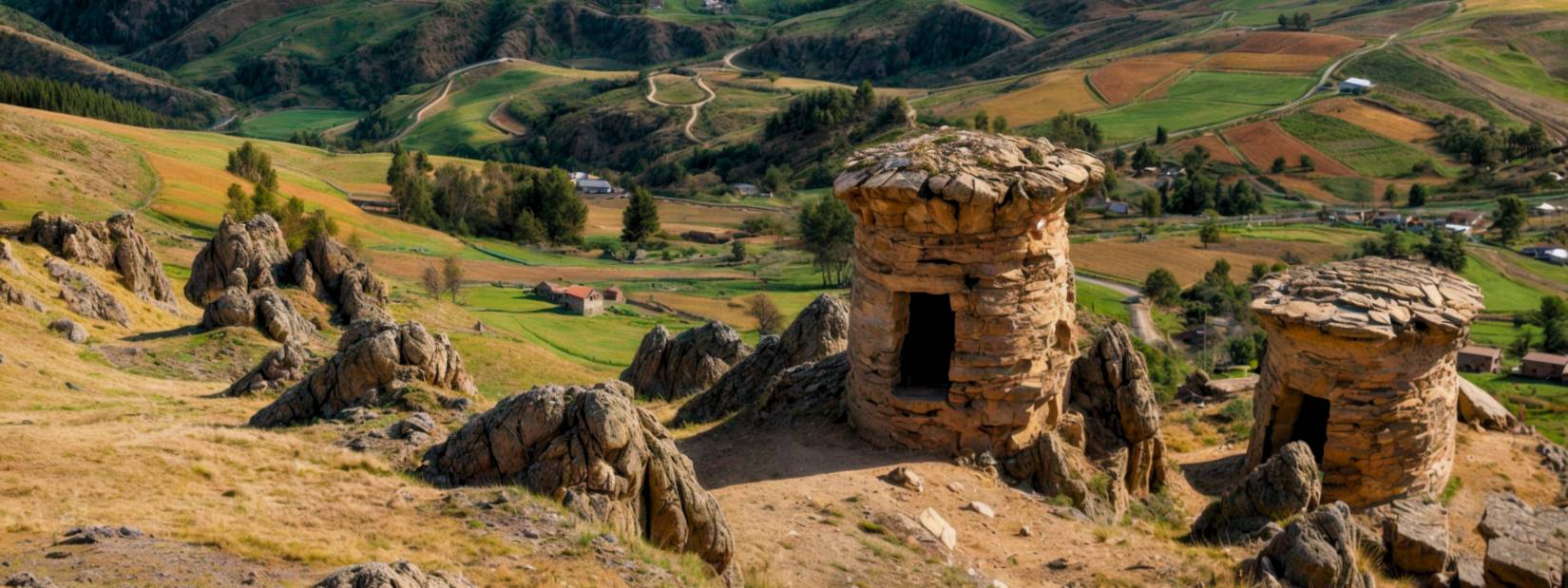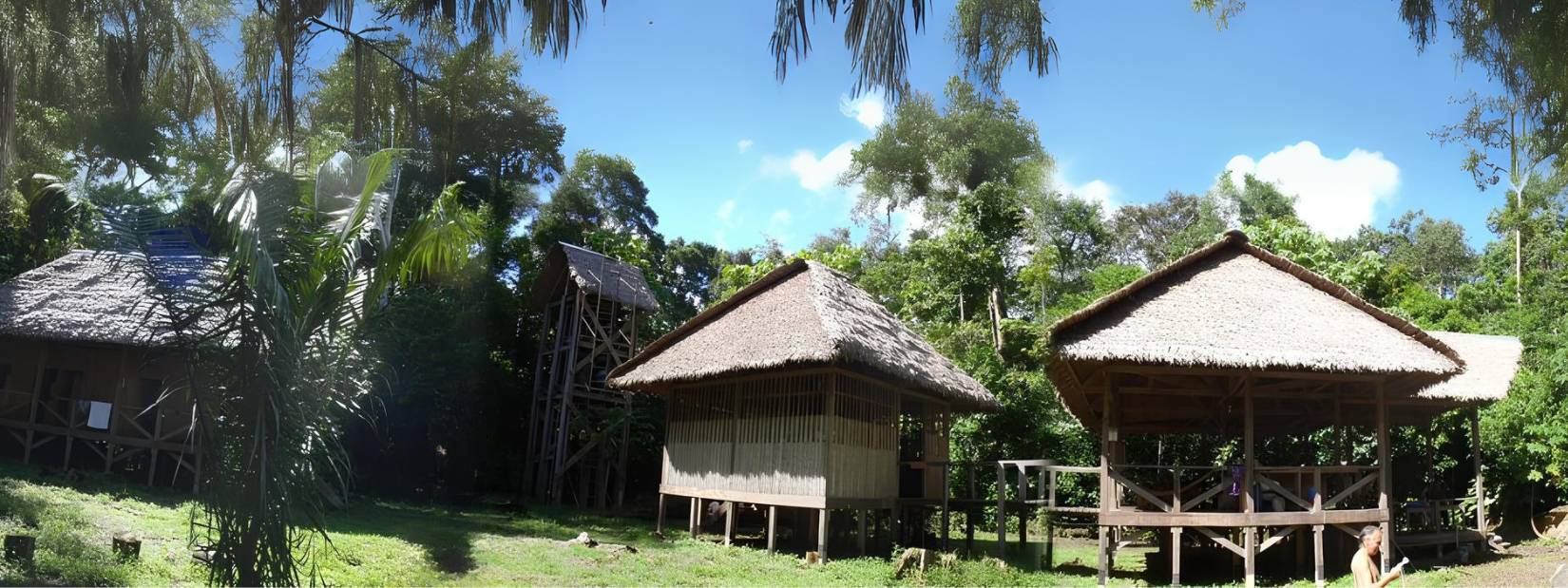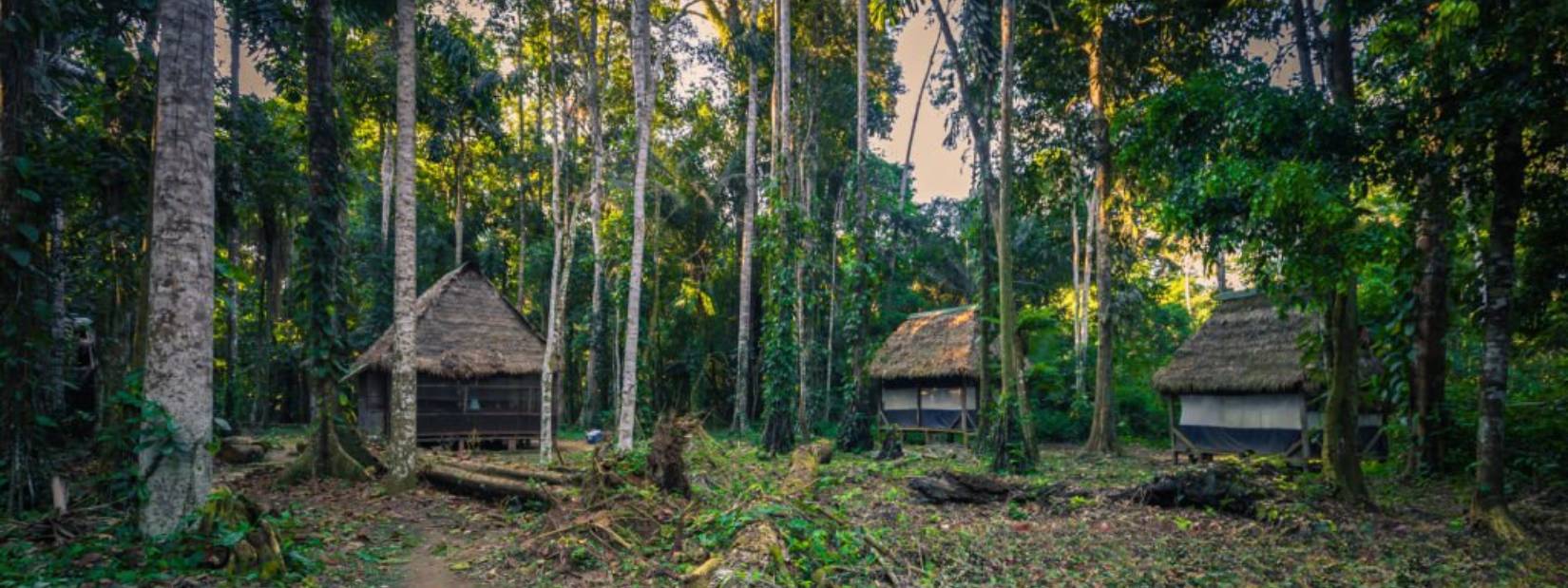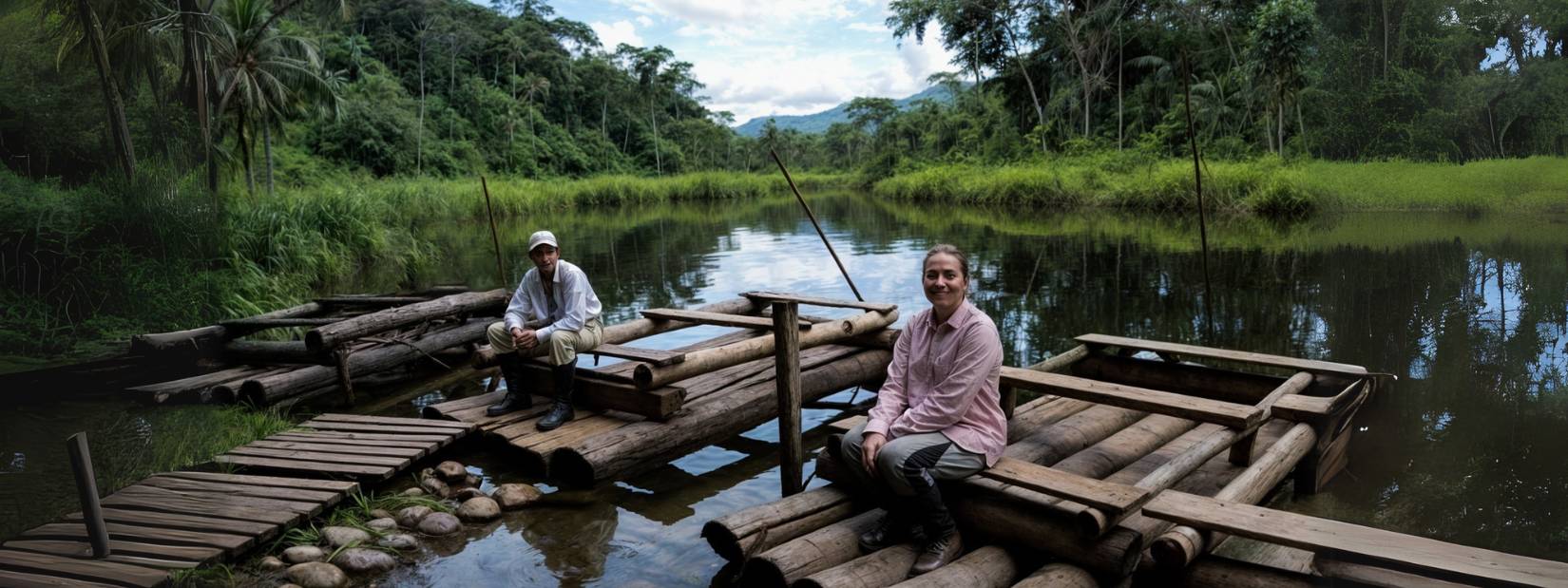Peru Rainforest Tour
The Manu National Park, a World Heritage Site, is one of the areas with the greatest biodiversity on the planet. It is located in the departments of Cusco and Madre de Dios.
Description
The Park was created on May 29, 1973, has an area of 1,716,295.22 hectares and is one of the best destinations for nature tourism. In the lower basin of the Manu River, the exuberance of the Amazon plain stands out.
One of the main attractions of the Park are the "collpas", habitat of flocks of guacayamos, as well as other species of fauna, that come in search of food. The park is home to some 221 species of mammals, such as the otorongo, black tiger, sachavaca, sajino, deer, ronsoco, black maquisapa, among others. As for birds, the harpy eagle, jabiru, pink spatula, jungle goose and cock of the rocks stand out.
The Manu has one of the most renowned research centers for the Amazon: the biological station of Cocha Cashu, as well as an interpretation center in the surveillance post of Limonal. Much of the park is indigenous territory.
Here live 30 peasant communities that maintain the Quechua language as their mother tongue and several native Amazonian populations such as the Matsiguenka, Amahuaca, Yine, Amarakaeri, Huashipaire and Nahua peoples. In addition there are indigenous populations in voluntary isolation called uncontacted. The cultural richness of the place is also evident in archaeological sites that have not yet been studied.
What to Expect
Quick Itinerary:
Day 01: Cusco - Ninamarca - Soga de Oro Lodge
Day 02: Soga de Oro Lodge - Machiguenga Lodge
Day 03: Casa Matsiguenga - Cocha Salvador - Cocha Otorongo
Day 04: Casa Matsiguenga - Dorado Lodge
Day 05: Dorado Lodge - Port Atalaya - Cusco
Many Reasons for Visit the Manu
- The Manu is one of the richest natural areas in biological diversity of the planet. Its great biodiversity is due to the fact that it covers diverse ecosystems, such as the puna, the cloud forest, the high forest and the Amazonian plain.
- It is considered one of the 7 natural wonders of the planet and houses 20 thousand plant species, 1000 species of birds, 222 species of mammals and large figures yet to be defined of reptile, amphibian, fish and insect species that inhabit their diverse ecosystems.
- In the Manu it is possible to observe species in danger of extinction more frequently than in other protected natural areas, such as the case of the giant river otter or giant otter and black caimans. In addition, you have the possibility to spot hard-to-see species such as the jaguar and the tapir.
- The route of the Manu, known worldwide as Manu Road, is considered by the birdwatchers within the Top 10 of the planet, due to its spectacular diversity of bird species as the path descends through its different ecosystems.
- This is one of the last refuges on the planet for natives who have no contact with civilization. They are nomadic tribes that live only from the resources obtained from the forest in which they live. Although their sighting is very difficult and should be avoided at all costs, it is necessary to respect their condition of voluntary isolation and keep distance in case of encounters.
Itineray Details
Day 1: Cusco - Ninamarca - Soga de Oro Lodge
We left Cusco early in the morning to start our Peru Rainforest Tour!
First, they take us by private transport to a place called Ninamarca to observe the pre-Inca chullpas (tombs) of the Lupaca culture. Then, we continue to Paucartambo, a colonial city with narrow streets and a beautiful church, where people still preserve their ancient customs.
Then, we ascend to the "Tres Cruces" viewpoint (3,900 masl) to observe a beautiful view of the Amazon basin if the weather permits. From there, we began to descend to Manu National Park, home to species such as the cock of the rocks (Peruvian national bird), hummingbirds, brightly colored quetzals, trogons, flycatchers and woolly monkeys. In terms of flora, we can see a variety of orchids, mosses, ferns, etc.
Finally, we will arrive at the port of Atalaya (500 masl), there we will board a motorized boat towards the rustic Soga de Oro Lodge with private bathroom and hot shower. After dinner we take a night walk in the Manu Amazonas.

Day 02: Soga de Oro Lodge - Machiguenga Lodge
After breakfast, we will board a motorized boat to travel along the Madre de Dios River to change for a navigation on the Manu River that offers us other incredible views of a great variety of species that live in and around, such as groups of turtles, white alligators, capybaras, jaguars (Panthera onca) that rest on a trunk and observe their territory. We arrived in the afternoon to our Machiguenga Lodge.
Later, our guide takes us to Otorongo Oxbow Lake, where an observation tower is placed that allows us to see the giant otters that live there. During that time, the Guide teaches us functions and secrets of the jungle. After that, we returned at night to the Machiguenga lodge.
At night we walk around the lodge, and then return to sleep. It has showers and bathrooms available in the accommodation.

Day 03: Casa Matsiguenga - Cocha Salvador - Cocha Otorongo
Today we will visit Cocha Salvador, located 30 minutes from Cocha Otorongo. We visit the lake to paddle in silence on a catamaran that gives us the chance to observe a family of playful giant river otters, the largest freshwater carnivores in the world, they are still common only in Manu. Each animal consumes between 4 and 5 kilos of fish daily. You can often see them eating large fish on logs at the lake's edge. Observing, as well as many species of rare birds, including a prehistoric bird called Shansho, Heron, cormorants, water duck, horned scream, turtles, Taricaya, black alligators.
The rest of the day you will go through the trails in the area looking for some of the 13 species of Monkey such as Black Spider Mokey, Red Howler Monkey Night Monkey, Dusky Titi Monkey, Saddleback Tamarin, Brown Capuchin Monkey and some mammals found here, bear giant anthill, South American coati, two-toed sloth, deer, a group of peccaries, which is found in the forest here, our guide will explain some of the basics of the rainforest ecosystems and will point out some of the medicinal plants of the area that the locals use. indigenous groups. You can be sure that the animals here in the wild Manu Amazon have never suffered from people hunting!
In the afternoon, we return to our Lodge in Otorongo, we have showers and toilets available in the National Reserve Center of Manu.

Day 04: Casa Matsiguenga - Dorado Lodge
Today again the call of the red howler monkey (Alouatta seniculus) will wake us up.
Again we embark on our motor boat to begin our return by the Manu River, and one can understand why it is so famous for its wildlife. On the banks of the river, you will see groups of turtles, white alligators (Caiman cocodrylus), capybaras (Hydrochaeris) and perhaps a Jaguar (Panthera Onca) that rests on a trunk and observes its territory.
In the afternoon we will arrive at the hostel, where we will settle in our respective rooms and then we will take a walk through our hostel. After dinner, we will have a night activity.
We sleep in the lodge, which has showers and toilets available.

Day 05: Dorado Lodge - Port Atalaya - Cusco
Today we get up very early. After breakfast, on the last day of the trip, we packed up the boat and began to navigate the Madre de Dios River to the port of Atalaya, where our private vehicle awaits us back to the City of Cusco.
Approximately we will arrive to the city of Cusco from 7:00 pm to 8:00 pm.

Included
Included
- Overland transport (Private vehicle)
- River transportation (Motorboat)
- Accommodation: 4 nights in jungle lodge
- Professional naturalist guide
- Meals during the trip
- Entrance to the Manu National Reserve
- Professional chef
- Meals: 4 breakfasts, 5 lunches, 4 dinners. and drinking water. Note: vegetarian option available upon request at no additional cost
- First aid kit
- Radiocommunications for trips to the jungle
- Rubber boots
Not Included
- Flights and departure taxes from the airport
- Breakfast on the first day and dinner on the last day
- Personal expenses such as beverages, telephone call, tips, etc.
- Travel insurance
- Vaccinations for trips to the jungle
- Tips to local staff
Essential Information
FAQ's about Peru Rainforest Tour
How is the climate in Manu?
On sunny days the temperature varies from 25 to 40 ° C during the day and from 10 to 20 ° C during the night. June and July are the coldest month. We will inform you of the current weather conditions before leaving on a tour.
Do I have to be in form to make this tour?
For our trips it is necessary to be in good physical health, but the form depends on the itinerary you choose. The areas where we walk are flat. We always walk very slowly in the jungle, since it is the best way to observe the flora and fauna, but also because it can be very hot and humid. If you take one of our tours, then you will be walking from 3 to 4 hours per day, carrying only a small day pack to carry your water, binoculars and camera.
What tipe of clothing should I bring?
The clothes that you see fit that are not very colorful, since the light colors intimidate the animals. Preferably camouflaged or dark. Polo shirts, pants, shores, lightweight, swimwear.
Do you have a near hospital?
In the expeditions that we carry out, there are not very close hospitals. But we have a first-aid kit and well-equipped first-aid kit. In case of any incident we evacuate as soon as possible. Attention If you suffer from any personal illness, it is recommended to take your personal medications.
What Facilities do you have in our accomodations?
The hostel has double and twin rooms, shared bathrooms and toilets, dining room, kitchen, two platforms for tents, hammocks and sunbeds, we also have double rooms with private bathroom and shower, available for a supplement. There is electricity available in the rooms for the light and the installation to charge the batteries is available in the dining room, the electricity is from solar panels, so the availability depends on the climate.
What do our tours include?
Depending on the program, the following things are included:
- Private transportation (bus and boat) we provide bus and boat transportation according to the number of travelers on travel
- Canvas bags. Canvas bags are quite waterproof, but we recommend that you place your belongings in plastic bags first before putting them in your duffel bags to protect your things from rain and moisture.
- Professional bilingual local guide. Our tour guide is from the area all professional and bilingual, passionate about wildlife and their work, well equipped with everything you need to help you enjoy the wildlife.
- Bottle of mineral water, only for the first day - while traveling - bring your own bottle full of water that can then be refilled each day in the shelters where large bottles of water are available.
- First aid kit. Yes, we have a first aid kit with us, but we also recommend bringing a small first aid kit (basic first aid items), also an antidote for the snake bite.
- 3 meals a day, when traveling by bus and boat, a main dish will be served, when you are in the lodging meals will be buffet style. Cook's staff will travel with us all the time.
What do you have to bring in the jungle?
- Good binoculars (10 x 42) are essential, animals can often be at a distance, or high up in the trees,
- Insect repellent (with at least 25% deet) and after the bite. - In addition to protective clothing we recommend bringing an insect repellent with a minimum of 35% deet. We recommend bringing something from home, since strong insect repellents can be hard to find in Cusco
- Flashlight with spare bulbs and additional batteries. -We have solar panels or generators in our cabins that are available to charge the batteries, weather permitting. You will need a good flashlight (a main torch is the best) and be sure to bring enough extra batteries. We are going to take nocturnal walks, where we will walk in a single file, so each person needs their own.
- Pocket money for soft drinks or beers and crafts and among others preferably bring in soles.
Travel Recommendations
- Wear light and light clothing, swimwear, something waterproof (if it rains), sandals and mosquito repellents.
- The rainy season is from January to March, but unexpected rain can occur all year round. The recommended season is April - December. Apply the vaccine against yellow fever 72 hours in advance.
- Also, it is very important to wear sunglasses with UV protection, sunscreen and lipstick.
- Due to height, dizziness, headache and nausea are common. Therefore, it is advisable to hydrate with coca infusions and take remedies such as Coramina, Gravol or Sorojchi pills.
BOOK NOW










